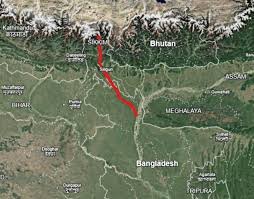
China's misadventure on Teesta river: Thousands rally in Bangladesh threatens India's security; Caution needed on 'Chicken Neck' route
Dhaka/New Delhi, October 25, 2025: The decades-long dispute between India and Bangladesh over the sharing of Teesta river water has now taken a new turn. With China's support, the Bangladesh government has accelerated the 'Testa River Master Plan', which has led thousands of citizens and students in northern Bangladesh to take to the streets. In this big rally, the protesters supported this China-backed project by raising slogans of 'Water Justice for Teesta'. However, there is an atmosphere of concern in Delhi as this project is very close to India's 'Chicken Neck' i.e. Siliguri Corridor. According to experts, it is part of China's Belt and Road Initiative (BRI) and may pose a threat to the security and water management of India's northeastern states.
A grand rally scene: Torchlight procession awakens northern Bangladesh
A grand rally in Rangpur and Lalmonirhat districts of northern Bangladesh on October 19 heated up the atmosphere before the monsoon. Hundreds of students from Chittagong University, local farmers and citizens took to the streets carrying torches. The streets were filled with slogans like ΓÇÿChina-backed Teesta Plan is needed!ΓÇÖ and ΓÇÿDistribute water equitably!ΓÇÖ The rally was organized with the support of the Bangladesh Nationalist Party (BNP), which has promised to implement the project immediately if it comes to power. The main argument of the protesters is that the project will be a ΓÇÿlifelineΓÇÖ for drought-stricken areas of northern Bangladesh. It is necessary as a solution to the problem of water scarcity during the dry season and flooding during the monsoon.
A student who participated in the rally said, "Agriculture in our area has been destroyed. The water of the Teesta river has not been distributed properly, which has increased unemployment. This master plan of China will give us a new life." The rally was not just a protest, but also an identification of the social and economic crisis that has arisen on the banks of the Teesta river. The interim government of Bangladesh has indirectly supported this rally, and the project was discussed during the visit of Chief Adviser Muhammad Yunus to Beijing in March 2025.
Teesta Master Plan: A 50-year mega project, $2.1 billion investment from China
The Teesta river is a 414-km-long river flowing from the mountains of Sikkim through West Bengal and Bangladesh. The master plan is designed for 50 years, and includes dredging the river, construction of dams and embankments, flood control, irrigation improvement and development of new townships on the banks of the river. The Bangladesh government has invited Chinese companies for this project, proposing an investment and loan of $2.1 billion. The project is not just about water management, but also about agriculture, livelihoods and ecological balance.
China's role has given the project an international dimension. During his visit to Beijing, Xi Jinping assured Muhammad Yunus of technical and financial assistance. Experts say that it is part of the BRI and could affect the Brahmaputra River, like China's hydroelectric projects in Tibet. It is an effort to strengthen China's grip on Bangladesh and aims to increase military and economic influence through infrastructure.
India's 'chicken neck' concern: Chinese incursion on the border?
The project is highly sensitive for India. The Teesta river dispute has been going on since 1983, when a temporary water-sharing agreement was signed but never implemented. In 2011, when the new agreement was in the final stages, the then West Bengal Chief Minister Mamata Banerjee refused, which broke off the talks. Since then, Bangladesh has been accusing India of 'water retention'. Now, the dispute has become complicated with China's involvement.
The Siliguri Corridor, also known as the 'Chicken Neck', is a narrow stretch of land, just 20-22 km wide, that connects the northeastern states of India (Assam, Arunachal Pradesh, Nagaland, etc.) with the mainland. Since the Teesta project is very close to this corridor, China's presence could pose a security threat. Experts believe that it is an attempt to gain control over intelligence surveillance, military activities and water sharing. Moreover, as the 1996 Ganga Water Treaty expires in 2026, water sharing is due to be renegotiated, in which the Teesta issue will be a key issue.
Political analyst Dr. Rajiv Sikta says, "This effort by China is not just economic but strategic. India should now increase bilateral talks with Bangladesh and focus on water management at the SAARC level. Otherwise, the security of Northeast India will be at risk." The Indian government has not yet given an official response, but internal discussions on the issue are reportedly underway in the Ministry of External Affairs.
Historical Background and Future Challenges
The Teesta dispute has deep roots. From Bangladesh's perspective, more than 1 million farmers in the northern region depend on this river. India does not release water during the dry season, but during the monsoon season, the excess water causes floods. This destroys agriculture and weakens the economy. India, however, says that this water is necessary to protect the rights of farmers in West Bengal. With China's involvement, this dispute has reached the Asian level. There are fears that Teesta will also be affected, like the Brahmaputra dams in Tibet. Environmental expert Savitri Roy said, "This project can upset the ecological balance. The river basin
Dhaka/New Delhi, October 25, 2025: The decades-long dispute between India and Bangladesh over the sharing of Teesta river water has now taken a new turn. With China's support, the Bangladesh government has accelerated the 'Testa River Master Plan', which has led thousands of citizens and students in northern Bangladesh to take to the streets. In this big rally, the protesters supported this China-backed project by raising slogans of 'Water Justice for Teesta'. However, there is an atmosphere of concern in Delhi as this project is very close to India's 'Chicken Neck' i.e. Siliguri Corridor. According to experts, it is part of China's Belt and Road Initiative (BRI) and may pose a threat to the security and water management of India's northeastern states.
A grand rally scene: Torchlight procession awakens northern Bangladesh
A grand rally in Rangpur and Lalmonirhat districts of northern Bangladesh on October 19 heated up the atmosphere before the monsoon. Hundreds of students from Chittagong University, local farmers and citizens took to the streets carrying torches. The streets were filled with slogans like ΓÇÿChina-backed Teesta Plan is needed!ΓÇÖ and ΓÇÿDistribute water equitably!ΓÇÖ The rally was organized with the support of the Bangladesh Nationalist Party (BNP), which has promised to implement the project immediately if it comes to power. The main argument of the protesters is that the project will be a ΓÇÿlifelineΓÇÖ for drought-stricken areas of northern Bangladesh. It is necessary as a solution to the problem of water scarcity during the dry season and flooding during the monsoon.
A student who participated in the rally said, "Agriculture in our area has been destroyed. The water of the Teesta river has not been distributed properly, which has increased unemployment. This master plan of China will give us a new life." The rally was not just a protest, but also an identification of the social and economic crisis that has arisen on the banks of the Teesta river. The interim government of Bangladesh has indirectly supported this rally, and the project was discussed during the visit of Chief Adviser Muhammad Yunus to Beijing in March 2025.
Teesta Master Plan: A 50-year mega project, $2.1 billion investment from China
The Teesta river is a 414-km-long river flowing from the mountains of Sikkim through West Bengal and Bangladesh. The master plan is designed for 50 years, and includes dredging the river, construction of dams and embankments, flood control, irrigation improvement and development of new townships on the banks of the river. The Bangladesh government has invited Chinese companies for this project, proposing an investment and loan of $2.1 billion. The project is not just about water management, but also about agriculture, livelihoods and ecological balance.
China's role has given the project an international dimension. During his visit to Beijing, Xi Jinping assured Muhammad Yunus of technical and financial assistance. Experts say that it is part of the BRI and could affect the Brahmaputra River, like China's hydroelectric projects in Tibet. It is an effort to strengthen China's grip on Bangladesh and aims to increase military and economic influence through infrastructure.
India's 'chicken neck' concern: Chinese incursion on the border?
The project is highly sensitive for India. The Teesta river dispute has been going on since 1983, when a temporary water-sharing agreement was signed but never implemented. In 2011, when the new agreement was in the final stages, the then West Bengal Chief Minister Mamata Banerjee refused, which broke off the talks. Since then, Bangladesh has been accusing India of 'water retention'. Now, the dispute has become complicated with China's involvement.
The Siliguri Corridor, also known as the 'Chicken Neck', is a narrow stretch of land, just 20-22 km wide, that connects the northeastern states of India (Assam, Arunachal Pradesh, Nagaland, etc.) with the mainland. Since the Teesta project is very close to this corridor, China's presence could pose a security threat. Experts believe that it is an attempt to gain control over intelligence surveillance, military activities and water sharing. Moreover, as the 1996 Ganga Water Treaty expires in 2026, water sharing is due to be renegotiated, in which the Teesta issue will be a key issue.
Political analyst Dr. Rajiv Sikta says, "This effort by China is not just economic but strategic. India should now increase bilateral talks with Bangladesh and focus on water management at the SAARC level. Otherwise, the security of Northeast India will be at risk." The Indian government has not yet given an official response, but internal discussions on the issue are reportedly underway in the Ministry of External Affairs.
Historical Background and Future Challenges
The Teesta dispute has deep roots. From Bangladesh's perspective, more than 1 million farmers in the northern region depend on this river. India does not release water during the dry season, but during the monsoon season, the excess water causes floods. This destroys agriculture and weakens the economy. India, however, says that this water is necessary to protect the rights of farmers in West Bengal. With China's involvement, this dispute has reached the Asian level. There are fears that Teesta will also be affected, like the Brahmaputra dams in Tibet. Environmental expert Savitri Roy said, "This project can upset the ecological balance. The river basin
A grand rally scene: Torchlight procession awakens northern Bangladesh
A grand rally in Rangpur and Lalmonirhat districts of northern Bangladesh on October 19 heated up the atmosphere before the monsoon. Hundreds of students from Chittagong University, local farmers and citizens took to the streets carrying torches. The streets were filled with slogans like ΓÇÿChina-backed Teesta Plan is needed!ΓÇÖ and ΓÇÿDistribute water equitably!ΓÇÖ The rally was organized with the support of the Bangladesh Nationalist Party (BNP), which has promised to implement the project immediately if it comes to power. The main argument of the protesters is that the project will be a ΓÇÿlifelineΓÇÖ for drought-stricken areas of northern Bangladesh. It is necessary as a solution to the problem of water scarcity during the dry season and flooding during the monsoon.
A student who participated in the rally said, "Agriculture in our area has been destroyed. The water of the Teesta river has not been distributed properly, which has increased unemployment. This master plan of China will give us a new life." The rally was not just a protest, but also an identification of the social and economic crisis that has arisen on the banks of the Teesta river. The interim government of Bangladesh has indirectly supported this rally, and the project was discussed during the visit of Chief Adviser Muhammad Yunus to Beijing in March 2025.
Teesta Master Plan: A 50-year mega project, $2.1 billion investment from China
The Teesta river is a 414-km-long river flowing from the mountains of Sikkim through West Bengal and Bangladesh. The master plan is designed for 50 years, and includes dredging the river, construction of dams and embankments, flood control, irrigation improvement and development of new townships on the banks of the river. The Bangladesh government has invited Chinese companies for this project, proposing an investment and loan of $2.1 billion. The project is not just about water management, but also about agriculture, livelihoods and ecological balance.
China's role has given the project an international dimension. During his visit to Beijing, Xi Jinping assured Muhammad Yunus of technical and financial assistance. Experts say that it is part of the BRI and could affect the Brahmaputra River, like China's hydroelectric projects in Tibet. It is an effort to strengthen China's grip on Bangladesh and aims to increase military and economic influence through infrastructure.
India's 'chicken neck' concern: Chinese incursion on the border?
The project is highly sensitive for India. The Teesta river dispute has been going on since 1983, when a temporary water-sharing agreement was signed but never implemented. In 2011, when the new agreement was in the final stages, the then West Bengal Chief Minister Mamata Banerjee refused, which broke off the talks. Since then, Bangladesh has been accusing India of 'water retention'. Now, the dispute has become complicated with China's involvement.
The Siliguri Corridor, also known as the 'Chicken Neck', is a narrow stretch of land, just 20-22 km wide, that connects the northeastern states of India (Assam, Arunachal Pradesh, Nagaland, etc.) with the mainland. Since the Teesta project is very close to this corridor, China's presence could pose a security threat. Experts believe that it is an attempt to gain control over intelligence surveillance, military activities and water sharing. Moreover, as the 1996 Ganga Water Treaty expires in 2026, water sharing is due to be renegotiated, in which the Teesta issue will be a key issue.
Political analyst Dr. Rajiv Sikta says, "This effort by China is not just economic but strategic. India should now increase bilateral talks with Bangladesh and focus on water management at the SAARC level. Otherwise, the security of Northeast India will be at risk." The Indian government has not yet given an official response, but internal discussions on the issue are reportedly underway in the Ministry of External Affairs.
Historical Background and Future Challenges
The Teesta dispute has deep roots. From Bangladesh's perspective, more than 1 million farmers in the northern region depend on this river. India does not release water during the dry season, but during the monsoon season, the excess water causes floods. This destroys agriculture and weakens the economy. India, however, says that this water is necessary to protect the rights of farmers in West Bengal. With China's involvement, this dispute has reached the Asian level. There are fears that Teesta will also be affected, like the Brahmaputra dams in Tibet. Environmental expert Savitri Roy said, "This project can upset the ecological balance. The river basin

.jpg)
















